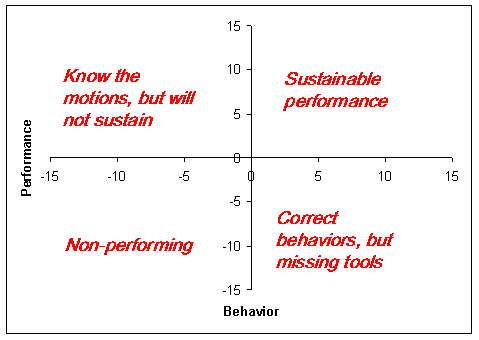Behavioral and mind developmental theories
The behavioral theory discussed from the works of B.F Skinner and John Watson combines theory, methodology, and elements of philosophy in expounding how animals and people behave (Skinner, 1984). It is also referred to as information processing theory since it investigates the inner activities of the human mind. According to Gazzaniga (2010), the theory assumes that it is possible to teach and learn the behavioral patterns of an individual.
Behavioral theory
Figure 1: Behavioral performance matrix.
The above matrix demonstrates how rules used in different settings can be followed when an individual adheres to correct behaviors. It is imperative to note that a child’s performance is rooted in behavior (Friesen, 2005). According to Gazzaniga (2010), rather than focusing on the characteristics of effective leadership and quick learning as advocated by trait theories, it is necessary to consider a child’s behavior
Implications of behavioral matrix and NAEYC’s code of conduct
In teaching practice, ethics is one of the most critical aspects since it creates much-needed objectivity and efficacy in meeting optimum service provision. Ethical demands, as stipulated in the NAEYC’s code of conduct, are critical because they link the objectives of teaching young children with proper strategies (Code of ethical conduct, 2005).
How do teachers, caretakers, and families handle ethical dilemmas among children? Are concerned teachers democratic or autocratic, permissive or directive, person-oriented, or task-oriented? Does some balance of the behavior of young children characterize teachers’ attitudes?
Brain development

The figure above demonstrates how to correct behavior cultivates a high level of performance in an individual. Darwall (2003) indicates that in the early learning stages of a child, person-oriented leadership assists in the development of positive behavioral patterns among children. The latter is possible through supportive, considerate, and non-punitive child-centered behavior.
Initiating structure is the extent to which a teacher takes charge to plan, organize, direct, and control a young child while performing a task. Considerate teachers to develop trust, friendship, and respect towards children.
Implications, brain development and NAEYC code of conduct
According to Code of ethical conduct (2005), initiating structure refers to task-oriented behavior in which teachers organize and define the relationships in a group, establish patterns and channels of communication as well as direct the working methods.
Consideration refers to person-oriented behavior in which the leader exhibits friendship, trust, respect, and warmth towards the subordinates. Considerate leaders express appreciation for a child’s progress.
References
Code of ethical conduct (2005). Web.
Darwall, S. (2003). Virtue Ethics, Oxford, NY: Wiley. Print.
Friesen, N. (2005). Mind and machine: ethical and epistemological implications for research. Thompson Rivers University, B.C., Canada.
Gazzaniga, M. (2010). Psychological Science. New York: W.W. Norton & Company. Print. Skinner, B.F. (1984). The operational analysis of psychological terms. Behavioral and Brain Sciences 7 (4): 547–581.